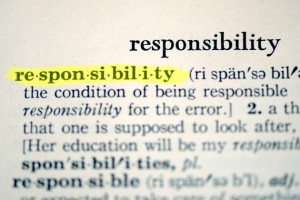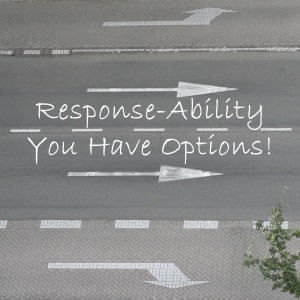Responsibility is a word with many meanings. The Oxford Dictionary definition offers:

- The state or fact of having a duty to deal with something or of having control over someone: women bear children and take responsibility for child care
- The state or fact of being accountable or to blame for something: the group has claimed responsibility for a string of murders
- The opportunity or ability to act independently and make decisions without authorization: we would expect individuals lower down the organization to take on more responsibility
- (Often responsibilities) a thing that one is required to do as part of a job, role, or legal obligation: he will take over the responsibilities of overseas director
- [In singular] (responsibility to/toward) a moral obligation to behave correctly toward or in respect of: individuals have a responsibility to control personal behavior
Most of us would likely agree with those definitions. Yet it is those very definitions that may be constricting our thinking, behavior and outcomes…
What if responsibility were defined as the ability to respond freely?
Response-ability: the ability to choose without reactivity? A leader who is constantly in reaction loses the ability to choose. How does that impact your communication, relationships, and effectiveness?
This happens over and over at work and home. We interpret responsibility as being about duty, control, accountable for others, etc. We hardly ever interpret responsibility as being about our own ability to respond. Yet that is the one thing that is within our sphere of influence.
Why? Because we have become accustomed to our reactions. They may be uncomfortable, but at least they are familiar. This is how we get stuck in dysfunctional communication patterns with bosses, subordinates, children, parents, and partners.
How would your communication and effectiveness improve if you could choose how to respond?
I have worked with clients who were willing to practice new ways in order to circumvent the old, familiar patterns that were keeping them “stuck.”
Amy had a long-standing pattern of negative conversations with her boss. He was difficult to read and more difficult to please. She became aware that she had reactive patterns around him, and that these were held in her body, mood and emotions. Learning to relax through breath, she opened the way for “response-ability.” She eventually learned how to engage in making effective requests, asking for more challenging assignments, and contributing to high-impact projects. Gradually she perceived herself differently, and evolved into the leader she truly was.
These are the 7 Steps to “Response-Ability” we used:
- Create awareness of your pattern
- Breathe deeply from abdomen to create deep relaxation and “response-ability”
- Choose emotions that promote feelings of open-heartedness and well-being
- Notice any sensations in the body where there is holding or discomfort
- See “what is as is”
- Breathe deeply to release the patterns of holding in the body
- Become response-able instead of reactive
The 7-step process sounds simple and it is. The challenge is that it requires consistent practice and repetition in order to be effectively used in high-stakes situations.
We invite you to share a Response-ability success story here.
To learn more about how you can develop this and other important leadership skills you might not yet know, I hope you’ll check out my new book, “Inner Switch: 7 Timeless Principles to Transform Modern Leadership.” You can purchase it from your favorite online retailer at www.susansfreeman.com.
I invite you to continue your learning journey with free tips and tools in my monthly newsletter, Inner Switch Leader Learning. No spam or list sharing. Ever. Click here to sign up: https://bit.ly/43e8Le5


